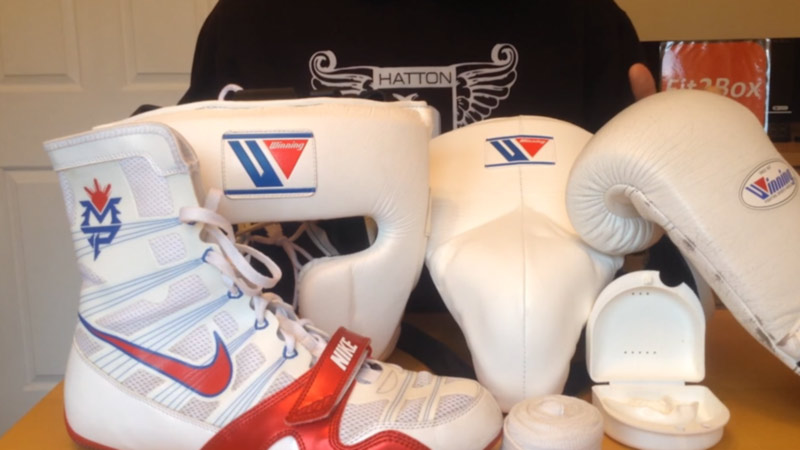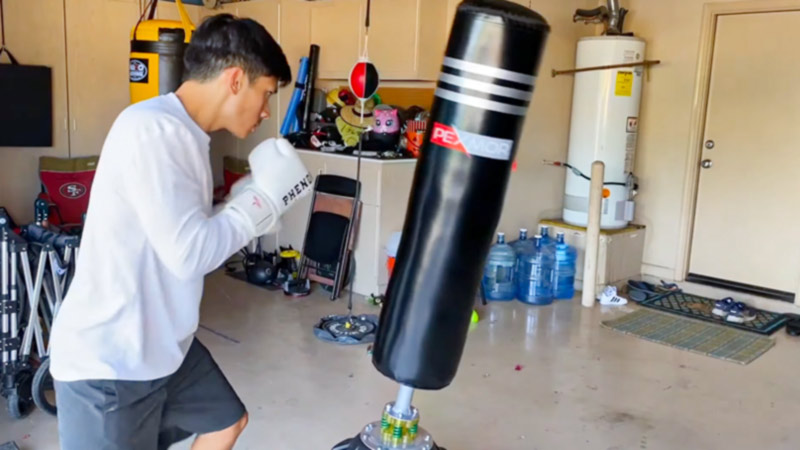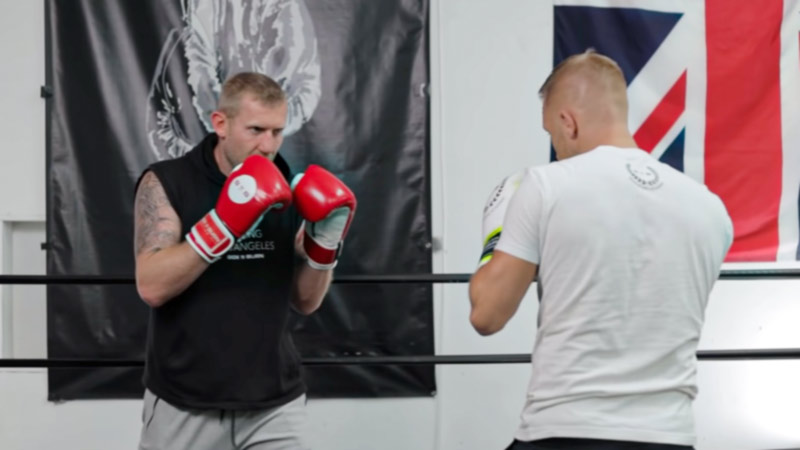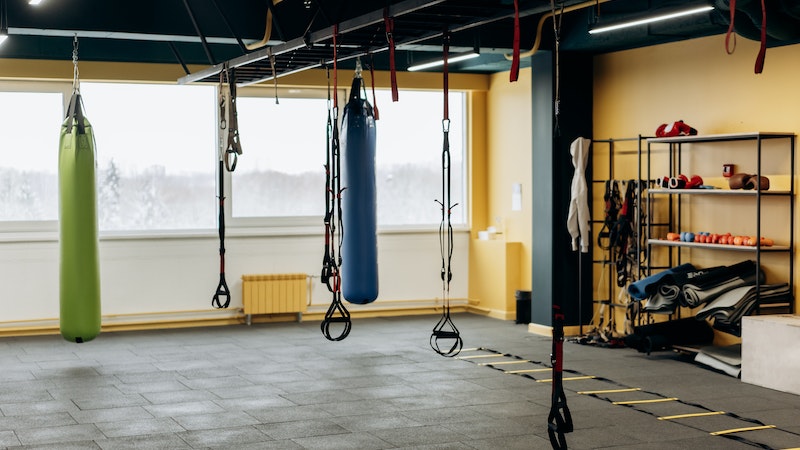Embarking on a journey into the world of boxing is an exciting endeavor that promises physical fitness, mental discipline, and the thrill of mastering a formidable sport.
As you step into the ring, the right equipment becomes your ally, ensuring safety, effectiveness, and the foundation for honing your skills.
Whether you’re a beginner eager to learn the ropes or someone considering boxing as a fitness routine, this guide will answer your burning questions about the equipment needed to kickstart your boxing journey. So, stay focused.
Do I Need a Lot of Equipment for Boxing?
Boxing equipment requirements can vary based on your level of involvement and goals. For beginners, essential gear includes hand wraps to protect your wrists and knuckles, well-fitting gloves for hand safety, and a mouthguard for dental protection.
As you progress, a heavy bag and jump rope can aid in training. More advanced practitioners might invest in a speed bag, double-end bag, and focus mitts for skill refinement. Protective headgear is vital for sparring sessions.
While a punching bag stand or wall-mounted bracket can be useful, they’re not obligatory. Overall, start with the basics and gradually expand your equipment arsenal as your commitment and skillset grow.
What Equipment Is Needed for Boxing?

Boxing requires a range of boxing materials and equipments to ensure safety, effective training, and skill development. The essential equipment includes:
Boxing Gloves
Choose gloves that fit properly and offer adequate hand and wrist support. Different gloves are designed for bag work, sparring, or competition.
Hand Wraps
Wraps provide additional wrist support and protect your knuckles. They help prevent injuries during training and sparring.
Mouthguard
Protect your teeth and mouth from impact during training and sparring sessions.
Protective Headgear
Essential for sparring, headgear minimizes the risk of head injuries while practicing with a partner.
Heavy Bag
A staple for developing power, endurance, and technique. Hanging bags or free-standing bags can be used.
Speed Bag
Improves hand-eye coordination, rhythm, and timing. It’s especially useful for refining quick punches.
Double-End Bag
Enhances accuracy, reflexes, and footwork. This moving target helps simulate real opponents.
Jump Rope
Aids in cardio conditioning, footwork, and overall agility.
Focus Mitts
These handheld targets allow for precision practice and are often used during partner training.
Punching Bag Stand or Mount

Required for hanging heavy bags securely. Some setups can accommodate multiple bag types.
Boxing Shoes
Designed for optimal ankle support and traction, helping you maintain stability while moving around the ring.
Groin Protector (Cup)
Ensures protection during training and sparring.
Sparring Gear
Apart from headgear, this includes body protectors, shin guards, and more for safe and controlled sparring sessions.
Gym Clothing
Comfortable workout attire that enables free movement is crucial.
Boxing Shorts and Jerseys
Specifically designed clothing for competitions, featuring the boxer’s unique style.
Water Bottle and Towel
Stay hydrated and keep a towel handy during intense training sessions.
Timer and Round Indicator
For structured rounds and interval training.
Medicine Balls and Resistance Bands
Used for strength and conditioning exercises that complement boxing training.
Remember, the extent of your equipment collection depends on your goals—whether you’re a beginner, training for fitness, or aiming for competitive boxing.
How Much Do I Need to Buy All Essential Equipment for Boxing?

The cost of essential boxing equipment can vary widely based on factors like brand, quality, and where you purchase them. Keep in mind that prices can change over time, and there might be sales or discounts available. Here’s a rough estimate of the cost of basic boxing equipment:
Boxing Gloves
A decent pair of boxing gloves can start around $30 and go up to $100 or more for higher-end brands.
Hand Wraps
Hand wraps are relatively inexpensive, usually ranging from $5 to $20.
Mouthguard
Basic mouthguards can cost as little as $5 to $10, while custom-fit ones might be around $20 to $40.
Protective Headgear
Good-quality headgear can range from $30 to $100 or more.
Heavy Bag
The cost of a heavy bag can vary greatly, from around $50 for basic bags to $200 or more for higher-quality ones.
Jump Rope
A basic jump rope can cost around $10 to $20.
Focus Mitts
A pair of focus mitts might be around $20 to $50, depending on the brand and quality.
Punching Bag Stand or Mount
If needed, these can range from $50 for basic stands to $150 or more for sturdier options.
Boxing Shoes
Decent boxing shoes can start around $50 and go up to $150 or more.
Groin Protector (Cup)
Basic protection might cost around $10 to $20.
Sparring Gear
Prices for sparring gear sets can vary but expect to pay around $50 to $100 or more for headgear, body protectors, and shin guards.
Gym Clothing
This depends on your preferences, but workout attire could cost around $20 to $50 per piece.
Water Bottle and Towel
These are relatively inexpensive, usually around $5 to $20.
Timer and Round Indicator
Basic interval timers can range from $20 to $50.
Medicine Balls and Resistance Bands
Prices vary widely, but a basic set might start around $20 to $30.
Overall, considering a mix of budget and mid-range options, you might be looking at a total cost of around $300 to $800 for essential boxing equipment.
This estimate doesn’t account for potential sales, discounts, or second-hand purchases, which could help reduce the overall cost.
How to Start Boxing Without Equipment?
Starting boxing without equipment is possible, and it can be a great way to get a feel for the sport before investing in gear. Here’s how to begin:
Basic Techniques and Footwork
Start by learning the fundamental boxing techniques and stances. Practice your footwork, including moving around, pivoting, and shifting your weight.
Shadow Boxing
Shadowboxing is a key component of boxing training. It involves throwing punches and moving as if you’re in a real fight, but without a partner or equipment. This helps you work on your form, coordination, and combinations.
Mimic Punches
Without gloves or a heavy bag, you can still practice the motions of different punches. Work on your jabs, crosses, hooks, and uppercuts, focusing on proper technique and fluid movement.
Jump Rope
Jumping rope is an excellent cardio workout that improves your footwork, coordination, and endurance. All you need is a jump rope and enough space to skip.
Bodyweight Exercises
Strengthen your muscles and improve your conditioning through bodyweight exercises. Include push-ups, squats, lunges, planks, and burpees in your routine.
Focus on Conditioning
Even without equipment, you can engage in high-intensity interval training (HIIT) to boost your cardiovascular fitness and stamina. Incorporate activities like sprinting, jogging in place, high knees, and mountain climbers.
Learn Boxing Basics
Study online resources, tutorials, and videos to understand the core principles of boxing, including defensive techniques, head movement, and how to generate power in your punches.
Footwork Drills
Create drills that focus on improving your footwork, such as practicing weaving and bobbing movements.
Visualization
Spend time visualizing yourself in the ring, executing different combinations and movements. Visualization can enhance your mental game and help you understand boxing strategies.
Focus on Core Strength
Core strength is essential for stability and generating power. Incorporate exercises like planks, Russian twists, and leg raises to strengthen your core muscles.
Practice Timing and Rhythm
Work on your timing and rhythm by practicing your movements to a metronome beat or rhythmic music.
Stretching and Flexibility
Dedicate time to stretching and improving your flexibility. Flexibility can enhance your range of motion and overall movement quality.
Mental Training
Boxing is as much a mental sport as it is physical. Begin developing mental toughness, focus, and concentration through meditation, mindfulness, and mental imagery.
Remember, while practicing without equipment can be helpful for building basic skills and understanding the sport, eventually, investing in proper equipment will be crucial as you progress.
How to Choose the Right Equipment for Boxing?
Choosing the right equipment for boxing is crucial for your safety, comfort, and overall performance. Here’s a step-by-step guide to help you make informed choices:
Assess Your Goals
Determine your goals in boxing. Are you training for fitness, self-defense, or competition? Your goals will influence the type of equipment you need.
Research Brands and Quality
Look for reputable brands known for producing high-quality boxing equipment. Read reviews and gather feedback from experienced boxers to identify reliable options.
Consult with Experts
Seek advice from experienced boxers, coaches, or trainers. They can provide valuable insights on suitable equipment based on your skill level and goals.
Fit and Sizing
Proper fit is essential for safety and performance. Whether it’s gloves, headgear, or shoes, make sure the equipment fits comfortably and securely.
Consider Your Budget
Determine how much you’re willing to invest in your boxing equipment. While quality matters, there are options available for various budget ranges.
Essential Equipment
Prioritize essential items like boxing gloves, hand wraps, and mouthguards. These items are crucial for safety and proper training.
Try Before You Buy
Whenever possible, try on equipment before purchasing. If you’re buying online, check the sizing charts provided by the manufacturer.
Material and Durability
Quality materials ensure longevity. Look for sturdy construction and materials that withstand wear and tear.
Glove Type
Different gloves are designed for various purposes. Bag gloves, sparring gloves, and competition gloves have different features. Choose according to your training needs.
Protection
Safety is paramount. Invest in proper protective gear like headgear, groin protectors, and shin guards, especially if you plan to spar.
Weight and Padding
Boxing gloves come in various weights and padding levels. Heavier gloves offer more protection, while lighter ones are better for speed and precision.
Try Before You Commit
If possible, borrow or rent equipment before purchasing. This gives you a chance to test the gear and see if it suits your preferences.
Online Reviews and Recommendations
Check online reviews from verified buyers and seek recommendations from boxing forums or communities.
Warranty and Return Policy
Ensure the equipment comes with a warranty and a flexible return policy in case you’re not satisfied.
Style and Aesthetics
While not the most critical factor, some boxers prefer equipment that reflects their personal style. Many brands offer a variety of colors and designs.
Proper Care
Consider how easy the equipment is to clean and maintain. Hygiene is crucial in boxing.
Try In-Store
If possible, visit a local sports store to physically try on equipment and get expert advice.
Long-Term Consideration
Choose equipment that aligns with your long-term goals. Investing in high-quality gear upfront can save you money in the long run.
Remember, your equipment choices will evolve as you progress in boxing. What works for a beginner might not suffice for an advanced boxer.
FAQs
What basic equipment do I need to start boxing?
To begin your boxing journey, you’ll require essential gear such as boxing gloves, hand wraps, and a mouthguard. These items protect your hands and teeth during training and form the foundation of your equipment arsenal.
Do I need a heavy bag from the start?
While a heavy bag is a valuable training tool, it’s not necessary when you’re just starting out. Focus on building fundamental techniques through shadow boxing, footwork drills, and bodyweight exercises. You can gradually incorporate a heavy bag as you progress.
What’s the difference between bag gloves and sparring gloves?
Bag gloves are designed for hitting heavy bags and pads, focusing on developing power and endurance. Sparring gloves, on the other hand, provide more padding and protection to ensure safe sparring sessions with a partner.
How important is proper fitting equipment?
Proper fitting equipment is essential for safety and optimal performance. Ill-fitting gloves or headgear can lead to discomfort, reduced effectiveness, and potential injuries. Take the time to find equipment that fits comfortably and securely.
Should I invest in high-end equipment as a beginner?
While high-quality equipment offers better durability and performance, beginners can start with mid-range options. As you progress and commit to boxing, gradually upgrading to more advanced gear becomes beneficial for enhancing your training experience.
Wrapping Up
As you embark on your boxing journey, the right equipment is your foundation for success. Starting with the basics—boxing gloves, hand wraps, and a mouthguard—ensures your safety and lays the groundwork for skill development.
Remember, the equipment you choose should align with your goals, whether you’re pursuing boxing as a fitness routine or aiming for competitive success. As you progress, you can expand your collection to include items like heavy bags, sparring gear, and focus mitts.
Ultimately, your dedication to the sport and your investment in suitable equipment will shape your boxing experience and journey toward mastery. Thank you.







